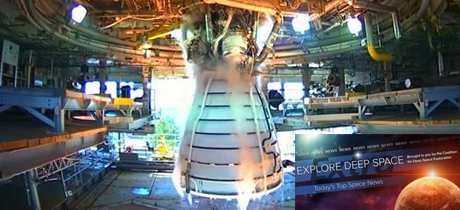In Today’s Deep Space Extra… Aerojet Rocketdyne and NASA’s Stennis Space Center reach a milestone in preparation of the Space Launch System (SLS) for its first four mission launches. A Russian resupply missions logs its second fast track flight to the International Space Station (ISS).
Human Space Exploration
Ensuring NASA’s Space Launch System (SLS) has the propulsion it needs
Coalition Member in the News – Aerojet Rocketdyne
Aerojet Rocketdyne (4/4): All 16 RS-25 Space Launch System (SLS) core stage main engines and vital controllers for the new NASA rocket’s first four missions have now been test fired for flight qualification at NASA’s Stennis Space Center in Mississippi. The SLS is to start astronauts of future missions of human deep space exploration, beginning with the Moon. Thursday marked the last of the engine tests, which spanned 500 seconds. Fourteen of the recently qualified SLS core stage engines have flown previously on board space shuttles. NASA’s shuttle fleet was retired in 2011. Two engines assembled from space parts were added to the SLS inventory and test fired. The flight controllers represent a major upgrade from the shuttle, with 20 times the processing capability and weighing 50 pounds less than the shuttle version.
Progress cargo freighter docks with Space Station after fast-track rendezvous
Spaceflightnow.com (4/4): Russia carried out its second fast track, two orbit launch to docking of a Progress cargo capsule with the six person International Space Station (ISS) early Thursday. The capsule carried 3.7 tons of Space Station propellant and crew supplies, including water and compressed breathing air. The typical Russian re-supply mission spans four orbits over six hours or 34 orbits over two days for the delivery of cargo and crew. The first of the latest fast tracks was carried out in July 2018 and they could become a crew transportation option at some point. Launched Thursday at 7:01 a.m., EDT, from the Baikonur Cosmodrome in Kazakhstan, the Russian space freighter docked at 10:22 a.m., EDT.
Houston Chronicle (4/4): Now a given, international cooperation in space dates back to the waning days of the Apollo program. It was in 1975 that a three person NASA Apollo crew rendezvoused in Earth orbit with a Soviet Soyuz spacecraft with two cosmonauts. That would set the stage for a post-Cold War collaboration in space that led to the assembly of an International Space Station (ISS) led by NASA and with Russia, Europe, Japan and Canada as partners, each making major hardware contributions and providing flight crews.
Space Science
Hayabusa2 begins descent to make artificial crater
NHK of Japan (4/4): Japanese space probe Hayabusa2 is making a descent toward the asteroid Ryugu in a new mission to create an artificial crater for a study of the celestial body’s interior. The asteroid is located 340 million kilometers from Earth. The Japan Aerospace Exploration Agency (JAXA), says the probe began its descent toward Ryugu from an altitude of 20,000 meters at around 1:00 p.m. on Thursday, Japan time.
Hayabusa-2: Japanese probe likely to have ‘bombed’ an asteroid
BBC.com (4/5): Its mission is to create an artificial crater on the asteroid Ryugu. If this is successful, it will later return to gather samples of the asteroid, which could help scientists understand how Earth was formed in the early Solar System. According to Kyodo News, the experiment’s success will only be confirmed in late April. The explosive device, called the Small Carry-on Impactor (SCI), was deployed by the Hayabusa-2 on Friday. The SCI is a 14kg conical container attached to the Hayabusa-2 and packed with plastic explosive. Per JAXA “The deployable camera, DCAM3, successfully photographed the ejector from when the SCI collided with Ryugu’s surface” and the Hayabusa-2 team tweeted HERE.
SpaceIL lander enters lunar orbit
SpaceNews.com (4/4): Israel’s Beresheet lunar probe maneuvered into orbit around the Moon on Thursday in preparation a landing attempt next week. The orbital maneuver occurred at 10:18 a.m., EDT, following a journey from Earth that began with a February 21 liftoff. A landing attempt at the Moon’s Sea of Serenity on the lunar near side is planned for April 11. Only, the U.S., Russia and China have accomplished the fete so far.
Curiosity captured two solar eclipses on Mars
NASA (4/4): With two moons, Phobos and Deimos, Mars offers NASA’s Curiosity rover, a resident of the Red Planet since August 2012, some interesting solar eclipses to observe.
Other News
NASA, Quebec astronaut help 13-year-old cancer patient’s wish come true
Montreal Gazette of Canada (4/3): Thirteen-year-old Canadian cancer patient Benjamin Lepage found inspiration in his recent visit to NASA’s Johnson Space Center (JSC), arranged through the Children’s Wish Foundation. His visit included a tour of spacecraft mock ups and an opportunity to speak with Canadian astronaut David Saint-Jacques, who is aboard the International Space Station (ISS), during a stop in Mission Control.
Business Insider (4/4): It was late Wednesday in Boca Chica near Brownsville, Texas, when SpaceX conducted a one second ground test firing of its Starhopper prototype. Starhopper is a forerunner of the company’s planned Starship, the upper stage for its new Falcon Heavy rocket.
Soyuz launch completes first-generation O3b constellation
SpaceNews.com (4/4): An Arianespace managed Soyuz rocket launch from French Guiana placed four O3b broadband communications satellites in orbit on Thursday, completing the constellation of 20 Ka band satellites. The launches began in 2013.

